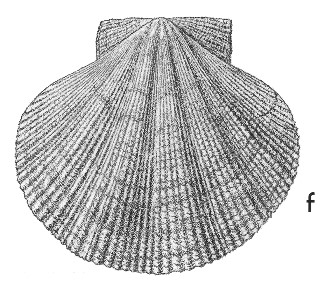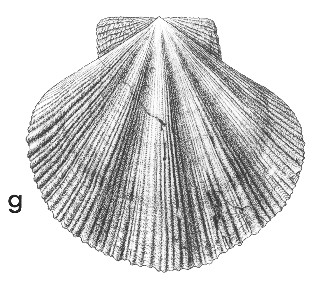
Revised descriptions of New Zealand Cenozoic Mollusca from Beu and Maxwell (1990)

 | Revised descriptions of New Zealand Cenozoic Mollusca from Beu and Maxwell (1990) | 
|
  (Pl. 33f): GS5240, Q21/f6501, right valve, Waihi Beach, Hawera, South Taranaki, Waipipian (GNS) |
  (Pl. 33g): GS5240, Q21/f6501, left valve, Waihi Beach, Hawera, South Taranaki, Waipipian (GNS) |
Beu & Maxwell (1990): Chapter 14; p. 278; pl. 33 f, g.
Synonymy: Pecten crawfordi Hutton 1873b, p. 32; Mesopeplum crawfordi
Type species of Borehamia Beu, 1978
Classification: Pectinidae
Description: Large for genus (90-125 mm high), calcitic, longer than high; right valve much more inflated than left; disc symmetrical in most specimens, elongated postero-ventrally (prosocline) in others; ears almost symmetrical, almost square, anterior ones retracted very slightly to disc, without byssal sinus or ctenolium. Dorsal margins of disc long and lightly concave, diverging at a very high angle, producing a very strongly convex ventral margin. Sculpture of 5 major radial folds in disc, evenly and regularly folded on both valves, very prominent on dorsal half of disc but becoming weaker lower down, fading out before ventral margin of large shells; superimposed on folds are many prominent, wide, closely to widely spaced radial costae, highly variable in width, spacing and numbers of secondary costellae; in most specimens, costae are relatively wide, flat-topped, and closely spaced on right valve but narrow-crested and more widely spaced on left valve; on many specimens, margins of costae are finely serrated by fine commarginal threads, which cross entire shell surface. Hinge lacks obvious teeth. Valves meet at thickened, flat-faced, narrowly triangular facets on each side of resilifer, at a nodule at outer base of each ear, and around ventral margin of commissure, leaving narrow anterior and posterior gapes. Adductor scar moderately large (0.2 height of disc), oval; pallial line broad, simple; many small muscle scars around pallial line dorsal to adductor scar, and in a curved line just above adductor scar.
Comparison: The complete lack of a functional byssus in even juvenile shells confirms the evidence from relative valve inflation — Mesopeplum crawfordi is one of the group of pectinids that lies on its more inflated right valve, and has an "aerofoil" cross-section for sustained, active swimming to escape predatory starfish, and never lives byssally attached. Members of this group (like most pectens) live on current-swept "hard-grounds", where sediment will not clog their gills, as they have only a poor mantle cavity cleaning mechanism. The very much larger size, the few, very prominent radial folds, the prominent, wide radial costae, and the relatively small, almost square ears readily distinguish M. crawfordi from the more ubiquitous species M. (Mesopeplum) convexum; earlier species (notably Waiauan, Tongaporutuan and Opoitian unnamed ones) of M. (Borehamia) are smaller than M. crawfordi, but are still larger than M. convexum. The much smaller Kapitean-early Opoitian species M. (Borehamia) toaense has more subdued radial folds but much more prominent, square-edged radial costae than those of M. crawfordi; specimens of M. toaense are very rare in the Momoe-a-Toa Shellbed, Chatham Island (type) but common in limestone and shellbeds in southern Wairarapa and at Tolaga and Anaura Bays, north of Gisborne.
Distribution: Opoitian-Waipipian; "Maungapakeha Taipo" (actually Mangapakeha hill, north of Taueru), east of Masterton, central Wairarapa (type); abundant and widespread in conglomerate, limestone, shellbeds and near-shore sandstone in Wanganui-South Taranaki (particularly at Waihi Beach, Hawera), Hawke's Bay, Wairarapa, Marlborough, and North Canterbury (particularly in Greenwood Formation in Lower Waipara Gorge near Greenwood's Bridge). One specimen is known from high in the type Nukumaruan sequence (Tewkesbury Formation) at Wanganui (reworked from Waipipian ?), and others from Five Fingers Peninsula, Doubtful Sound, are probably Nukumaruan, so M. crawfordi possibly existed outside the main sedimentary basins through Mangapanian and Nukumaruan time.
Cite this publication as: "A.G. Beu and J.I. Raine (2009). Revised
descriptions of New Zealand Cenozoic Mollusca from Beu and Maxwell (1990). GNS
Science miscellaneous series no. 27."
© GNS Science, 2009
ISBN
978-0-478-19705-1
ISSN 1177-2441
(Included with a PDF facsimile file
copy of New Zealand Geological Survey Paleontological Bulletin 58 in CD version
from: Publications Officer, GNS Science, P.O. Box 30368 Lower Hutt, New
Zealand)